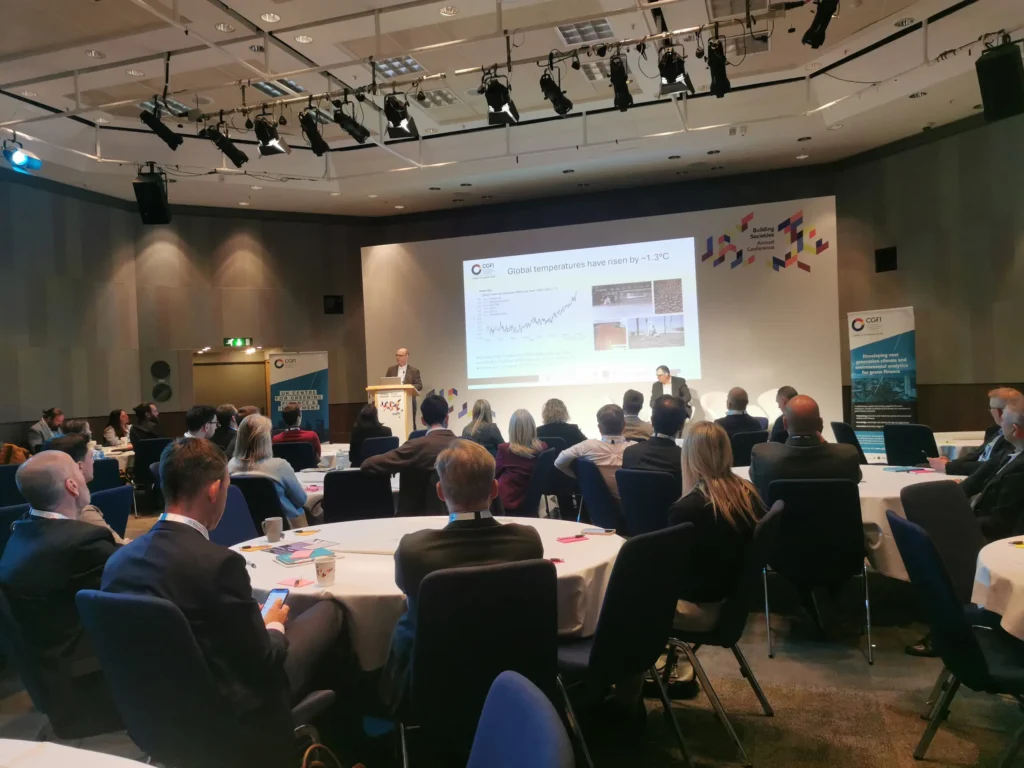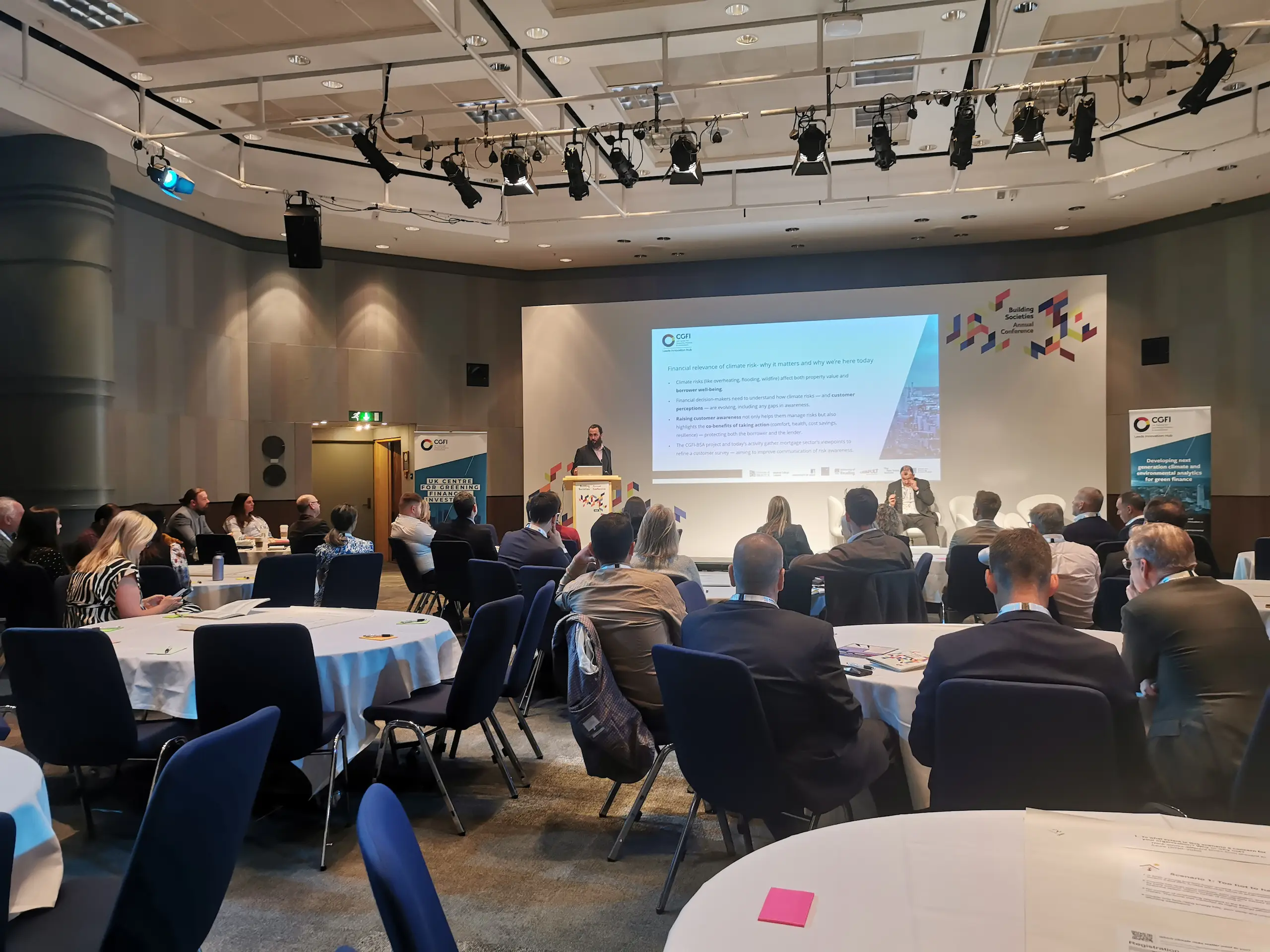Building Societies Annual Conference | 08 May 2025, Birmingham
At this year’s Building Societies Association (BSA) Annual Conference in Birmingham, the UK CGFI Leeds Innovation Hub, in collaboration with BSA, hosted a breakout session, ‘Communicating with customer on climate risk: barriers, motivations and opportunities for action’. This session aimed to explore how the sector can better support customers in understanding and responding to the increased risks of extreme weather events, such as flooding and overheating, resulting from the changing physical climate. Whilst there are many other extreme weather risks, flooding and overheating are the priority concerns. It was hosted in response to sector-wide recognition, highlighted at the previous year’s BSA Annual Conference, that the sector lacks access to information on physical climate risks, and that building societies need better tools to meet emerging responsibilities around customer duty and climate resilience.
Discussion
The event was chaired by Paul Broadhead, Head of Mortgage and Housing Policy at the BSA, who opened the discussion with a live poll asking which physical climate risks participants considered most important to their organisations – results were presented at the end of the session. He also highlighted the growing need for property-level resilience from extreme weather, and the crucial role of communication in enabling more informed, confident customer decisions.
Professor Jason Lowe OBE (University of Leeds / CGFI) provided insights into the state of UK physical climate risks contextualised by recent Met Office data showing 2024 as the UK’s fourth warmest year on record. He emphasised that intensifying rainfall, heat, and seasonal weather extremes are no longer distant threats, they are already impacting homeowners’ property, financial resilience, and insurability. He also suggested that future lending decisions should reflect this new risk reality.

Professor Iain Clacher (University of Leeds / CGFI) discussed the financial relevance of physical climate risks, emphasising that extreme weather like overheating and flooding impacts both property value and borrower well-being. He emphasised that lenders, brokers, and surveyors must understand the evolving risks and customer awareness level raising which offer co-benefits like comfort, health, and financial resilience — safeguarding both customers and lenders.
The group activity and homeowner scenarios were introduced to the participants: (i) an EPC A-rated home that becomes unbearably hot in summer, and (ii) a family moving to a flood-prone area with little advance warning or disclosure of flooding. The exercises were designed to foster discussion on both customer awareness and institutional responsiveness
Breakout
The session then moved into working groups, where participants from across the sector (lenders, surveyors, risk managers) explored one of the two homeowner risk scenarios: flooding and overheating. Participants discussed what could have been done differently to avoid or mitigate the risk, who within the mortgage chain could have provided better information, and what practical barriers currently prevent customers from making climate-aware decisions. The brief findings from the discussions are as follows:
How concerning are these scenarios for your organisation?
Overheating remains a low priority due to its omission from EPCs and risk frameworks, but with rising UK heatwaves, participants acknowledged a growing need for policy shifts and clearer communication. Flooding, while more recognised, still raised concerns about future insurability, resale value, and borrower vulnerability. Gaps in risk modelling and risk disclosure were highlighted, including the failure to incorporate localised climate projections into property assessments, the absence of overheating indicators in EPCs, with participants stressing the importance of protecting asset value and insurance access.
What could have been done differently before purchase to manage or reduce this risk?
Customers often lack meaningful extreme weather risk information before buying, especially during conveyancing. Industry-side suggestions included better integration of these risk into valuations, improved broker and lender guidance, and stronger disclosure regulations. Proposed solutions such as mandatory seller packs, a standardised UK central flood data portal for the sector, and EPC guidance for overheating risks with potential financial impacts due to increased energy consumption for cooling.
What enables customer action and how can the sector support it?
Key enablers include financial support in form of green loans and government grants, practical advice, and policy reforms. Trusted communication channels were seen as essential, especially when co-benefits like health and comfort were emphasised. For both extreme weathers risks, embedding adaptation into building housing regulation, mortgage policy, and improving access to green finance were widely supported.
What are the main barriers, for customers and professionals?
Barriers included affordability, lack of reliable information, and uncertainty about retrofit options. Lenders cited data limitations and low perceived urgency among consumers and institutions to prioritise climate risk in mortgage decision-making. Lenders face a commercial risk in acting alone on climate issues, and that collective industry action is needed to avoid competitive disadvantage. Behavioural resistance, misinformation, and policy inconsistency also hindered progress. Coordinated messaging and government-backed guidance were seen as critical.
Who should inform customers and how?
While views varied, there was agreement that communication must be consistent, accessible, and credible. Some called for national government leadership; others favoured a shared responsibility model involving local authorities, industry bodies (e.g. BSA), and regulators. A central, trusted platform was seen as essential to ensure clarity across the housing and mortgage ecosystem.
Reflections and Closing Remarks
Wrapping up the session, Professor Jason Lowe OBE noted whilst the sector is ready to act, there is a need for a customised communication tools to help the sector and its customers be informed about the risks, mitigation and adaptation solutions.
The live poll from the opening remarks results were shared: Which climate risks do you consider most important to your organisation? Flooding emerged as the top concern (39%), followed by storm damage (24%) and subsidence (19%). Sea level rise (12%) and overheating (4%) were less commonly identified, and wildfire was not selected by any participants.

Next steps were highlighted in terms of building on insights from the session, the project will now focus on designing the customer survey that aims to understand risk perceptions and knowledge gaps. These findings will then inform the framework development which will be used to design a communication tool that the sector can use to support climate-aware decision-making internally and for customers.
By combining climate science with behavioural and sector insights, the goal is to develop a practical communication tool that helps the sector, and its customers better understand and respond to flooding and overheating risks.




